Structural Diversity of Heteroleptic Cobalt(II) Dicyanamide Coordination Polymers with Substituted Pyrazines and Pyrimidines as Auxiliary Ligands †
Abstract
1. Introduction
2. Results and Discussion
2.1. Synthesis and General Characterization
2.2. Structural Analysis
3. Conclusions
4. Materials and Methods
Supplementary Materials
Author Contributions
Funding
Institutional Review Board Statement
Informed Consent Statement
Data Availability Statement
Acknowledgments
Conflicts of Interest
References
- Sun, N.; Shah, S.S.A.; Lin, Z.; Zheng, Y.Z.; Jiao, L.; Jiang, H.L. MOF-Based Electrocatalysts: An Overview from the Perspective of Structural Design. Chem. Rev. 2025, 125, 2703–2792. [Google Scholar] [CrossRef]
- Wan, Q.; Wakizaka, M.; Yamashita, M. Single-Ion Magnetism Behaviors in Lanthanide(III)-Based Coordination Frameworks. Inorg. Chem. Front. 2023, 10, 5212–5224. [Google Scholar] [CrossRef]
- Zhang, Y.; Liu, H.; Jin, Z. Polymetallic Coordination Polymers for Photocatalytic Hydrogen Production. ACS Sustain. Chem. Eng. 2023, 11, 16015–16029. [Google Scholar] [CrossRef]
- Xue, D.X.; Wang, Q.; Bai, J. Amide-Functionalized Metal–Organic Frameworks: Syntheses, Structures and Improved Gas Storage and Separation Properties. Coord. Chem. Rev. 2019, 378, 2–16. [Google Scholar] [CrossRef]
- Gao, Q.; Xu, J.; Bu, X.H. Recent Advances about Metal–Organic Frameworks in the Removal of Pollutants from Wastewater. Coord. Chem. Rev. 2019, 378, 17–31. [Google Scholar] [CrossRef]
- Cai, H.; Huang, Y.L.; Li, D. Biological Metal–Organic Frameworks: Structures, Host–Guest Chemistry and Bio-Applications. Coord. Chem. Rev. 2019, 378, 207–221. [Google Scholar] [CrossRef]
- Sun, J.K.; Yang, X.D.; Yang, G.Y.; Zhang, J. Bipyridinium Derivative-Based Coordination Polymers: From Synthesis to Materials Applications. Coord. Chem. Rev. 2019, 378, 533–560. [Google Scholar] [CrossRef]
- Kusamoto, T.; Nishihara, H. Zero-, One- and Two-Dimensional Bis(dithiolato)metal Complexes with Unique Physical and Chemical Properties. Coord. Chem. Rev. 2019, 380, 419–439. [Google Scholar] [CrossRef]
- Evans, J.D.; Garai, B.; Reinsch, H.; Li, W.; Dissegna, S.; Bon, V.; Senkovska, I.; Fischer, R.A.; Kaskel, S.; Janiak, C.; et al. Metal–Organic Frameworks in Germany: From Synthesis to Function. Coord. Chem. Rev. 2019, 380, 378–418. [Google Scholar] [CrossRef]
- Wang, P.; Fan, R.Q.; Yang, Y.L.; Liu, X.R.; Xiao, P.; Li, X.Y.; Hasi, W.; Cao, W.W. 1-D Helical Chain, 2-D Layered Network and 3-D Porous Lanthanide–Organic Frameworks Based on Multiple Coordination Sites of Benzimidazole-5,6-Dicarboxylic Acid: Synthesis, Crystal Structure, Photoluminescence and Thermal Stability. CrystEngComm 2013, 15, 4489–4506. [Google Scholar] [CrossRef]
- Robin, A.Y.; Fromm, K.M. Coordination Polymer Networks with O- and N-Donors: What They Are, Why and How They Are Made. Coord. Chem. Rev. 2006, 250, 2127–2157. [Google Scholar] [CrossRef]
- Schubert, U.; Hüsing, N. Synthesis of Inorganic Materials, 2nd ed.; Wiley-VCH: Weinheim, Germany, 2005. [Google Scholar]
- Li, N.; Feng, R.; Zhu, J.; Chang, Z.; Bu, X.H. Conformation Versatility of Ligands in Coordination Polymers: From Structural Diversity to Properties and Applications. Coord. Chem. Rev. 2018, 375, 558–586. [Google Scholar] [CrossRef]
- He, H.; Hashemi, L.; Hu, M.L.; Morsali, A. The Role of the Counter-Ion in Metal–Organic Frameworks’ Chemistry and Applications. Coord. Chem. Rev. 2018, 376, 319–347. [Google Scholar] [CrossRef]
- Elsaidi, S.K.; Mohamed, M.H.; Banerjee, D.; Thallapally, P.K. Flexibility in Metal–Organic Frameworks: A Fundamental Understanding. Coord. Chem. Rev. 2018, 358, 125–152. [Google Scholar] [CrossRef]
- Świtlicka, A. Recent Insights into Magneto-Structural Properties of Co(II) Dicyanamide Coordination Compounds. Magnetochemistry 2024, 10, 90. [Google Scholar] [CrossRef]
- García-Bena, J.; McHugh, L.N.; Bennett, T.D.; Bermúdez-García, J.M. Dicyanamide-Perovskites at the Edge of Dense Hybrid Organic–Inorganic Materials. Coord. Chem. Rev. 2022, 454, 214337. [Google Scholar] [CrossRef]
- Batten, S.; Murray, K. Structure and Magnetism of Coordination Polymers Containing Dicyanamide and Tricyanomethanide. Coord. Chem. Rev. 2003, 246, 103–130. [Google Scholar] [CrossRef]
- Pellei, M.; Del Bello, F.; Porchia, M.; Santini, C. Zinc Coordination Complexes as Anticancer Agents. Coord. Chem. Rev. 2021, 445, 214088. [Google Scholar] [CrossRef]
- Shi, Y.J.; Chen, X.T.; Li, Y.Z.; Xue, Z.; You, X.Z. Pb(dca)2 (dca = Dicyanamide): A Novel 3D Compound with Unusual Coordination Modes of Dicyanamide. New J. Chem. 2002, 26, 1711–1713. [Google Scholar] [CrossRef]
- Boča, R.; Boča, M.; Gembický, M.; Jäger, L.; Wagner, C.h.; Fuess, H. Versatile Coordination Mode of Dicyanamide in Nickel(II) Complexes Containing Polyamines as Blocking Ligands. Polyhedron 2004, 23, 2337–2348. [Google Scholar] [CrossRef]
- Papaefstathiou, G.S.; Escuer, A.; Mautner, F.A.; Raptopoulou, C.; Terzis, A.; Perlepes, S.P.; Vicente, R. Use of the Di-2-Pyridyl Ketone/Acetate/Dicyanamide “Blend” in Manganese(II), Cobalt(II) and Nickel(II) Chemistry: Neutral Cubane Complexes. Eur. J. Inorg. Chem. 2005, 2005, 879–893. [Google Scholar] [CrossRef]
- Frost, J.M.; Harriman, K.L.M.; Murugesu, M. The Rise of 3-d Single-Ion Magnets in Molecular Magnetism: Towards Materials from Molecules? Chem. Sci. 2016, 7, 2470–2491. [Google Scholar] [CrossRef] [PubMed]
- Feng, M.; Tong, M.L. Single-Ion Magnets from 3d to 5f: Developments and Strategies. Chem. Eur. J. 2018, 24, 7574–7594. [Google Scholar] [CrossRef]
- Batten, S.R.; Robson, R.; Jensen, P.; Moubaraki, B.; Murray, K.S. Structure and Molecular Magnetism of the Rutile-Related Compounds M(dca)2, M = Co(II), Ni(II), Cu(II), dca = Dicyanamide, N(CN)2−. Chem. Commun. 1998, 7, 439–440. [Google Scholar] [CrossRef]
- Jensen, P.; Batten, S.R.; Fallon, G.D.; Moubaraki, B.; Murray, K.S.; Price, D.J. Structural Isomers of M(dca)2 Molecule-Based Magnets: Crystal Structure of Tetrahedrally Coordinated Sheet-Like β-Zn(dca)2 and β-Co/Zn(dca)2, and the Octahedrally Coordinated Rutile-Like α-Co(dca)2, Where dca− = Dicyanamide, N(CN)2−, and Magnetism of β-Co(dca)2. Chem. Commun. 1999, 177–178. [Google Scholar]
- Pal, P.; Konar, S.; Lama, P.; Das, K.; Bauza, A.; Frontera, A.; Mukhopadhyay, S. On the Importance of Noncovalent Carbon-Bonding Interactions in the Stabilization of a 1D Co(II) Polymeric Chain as a Precursor of a Novel 2D Coordination Polymer. J. Phys. Chem. B 2016, 120, 6803–6811. [Google Scholar] [CrossRef]
- Świtlicka-Olszewska, A.; Palion-Gazda, J.; Klemens, T.; Machura, B.; Vallejo, J.; Cano, J.; Lloret, F.; Julve, M. Single-Ion Magnet Behaviour in Mononuclear and Two-Dimensional Dicyanamide-Containing Cobalt(II) Complexes. Dalton Trans. 2016, 45, 10181–10193. [Google Scholar] [CrossRef]
- Bhar, K.; Khan, S.; Sanchez Costa, J.; Ribas, J.; Roubeau, O.; Mitra, P.; Ghosh, B.K. Crystallographic Evidence for Reversible Symmetry Breaking in a Spin-Crossover d7 Cobalt(II) Coordination Polymer. Angew. Chem. Int. Ed. 2012, 51, 2142–2145. [Google Scholar] [CrossRef]
- Roy, S.; Choubey, S.; Bhar, K.; Sikdar, N.; Sánchez Costa, J.; Mitra, P.; Ghosh, B.K. Counter Anion Dependent Gradual Spin Transition in a 1D Cobalt(II) Coordination Polymer. Dalton Trans. 2015, 44, 7774–7776. [Google Scholar] [CrossRef]
- Wriedt, M.; Näther, C. Directed Synthesis of μ-1,3,5-Bridged Dicyanamides by Thermal Decomposition of μ-1,5-Bridged Precursor Compounds. Dalton Trans. 2011, 40, 886–898. [Google Scholar] [CrossRef]
- Palion-Gazda, J.; Choroba, K.; Machura, B.; Świtlicka, A.; Kruszynski, R.; Cano, J.; Lloret, F.; Julve, M. Influence of the Pyrazine Substituent on the Structure and Magnetic Properties of Dicyanamide-Bridged Cobalt(II) Complexes. Dalton Trans. 2019, 48, 17266–17280. [Google Scholar] [CrossRef]
- Vangdal, B.; Carranza, J.; Lloret, F.; Julve, M.; Sletten, J. Syntheses, Crystal Structures and Magnetic Properties of Copper(II) Dicyanamide Complexes: Dinuclear, Chain and Ladder Compounds. J. Chem. Soc. Dalton Trans. 2002, 566–574. [Google Scholar] [CrossRef]
- Dou, Y.-S. Equations for Calculating Dq and B. J. Chem. Educ. 1990, 67, 134. [Google Scholar] [CrossRef]
- Lever, A.B.P. Inorganic Electronic Spectroscopy; Elsevier: Amsterdam, The Netherlands, 1984. [Google Scholar]
- Faus, J.; Julve, M.; Lloret, F.; Muñoz, M.C. Magnetic Exchange in Dinuclear Copper(II) Complexes with Bridging Ligands. Inorg. Chem. 1993, 32, 2013–2017. [Google Scholar] [CrossRef]
- Shukla, D.; Gupta, L.K.; Chandra, S. Spectroscopic and Magnetic Studies of Copper(II) Complexes with N- and O-Donor Ligands. Spectrochim. Acta A 2008, 71, 746–750. [Google Scholar] [CrossRef] [PubMed]
- Maldonado-Rogado, M.A.; Viñuelas-Zahínos, E.; Luna-Giles, F.; Barros-García, F.J. Structural and Magnetic Characterization of Copper(II) Complexes with N,O-Donor Ligands. Polyhedron 2007, 26, 5210–5218. [Google Scholar] [CrossRef]
- Macrae, C.F.; Bruno, I.J.; Chisholm, J.A.; Edgington, P.R.; McCabe, P.; Pidcock, E.; Rodriguez-Monge, L.; Taylor, R.; van de Streek, J.; Wood, P.A. Mercury CSD 2.0—New Features for the Visualization and Investigation of Crystal Structures. J. Appl. Cryst. 2008, 41, 466–470. [Google Scholar] [CrossRef]
- Llunell, M.; Casanova, D.; Cirera, J.; Bofill, J.M.; Alemany, P.; Alvarez, S.; Pinsky, M.; Avnir, D. SHAPE: Continuous Shape Measures of Polygonal and Polyhedral Molecular Fragments, Version 1.1b; University of Barcelona: Barcelona, Spain, 2005. [Google Scholar]
- Alvarez, S.; Avnir, D.; Llunell, M.; Pinsky, M. Continuous Symmetry Maps and Shape Classification. The Case of Six-Coordinated Metal Compounds. New J. Chem. 2002, 26, 996–1009. [Google Scholar] [CrossRef]
- Yuoh, A.C.B.; Agwara, M.O.; Yufanyi, D.M.; Conde, M.A.; Jagan, R.; Eyong, K.O. Synthesis, Crystal Structure, and Antimicrobial Properties of a Novel 1-D Cobalt Coordination Polymer with Dicyanamide and 2-Aminopyridine. Int. J. Inorg. Chem. 2015, 106838. [Google Scholar] [CrossRef]
- Manna, H.M.T.; Ghosh, A.K.; Ribas, J.; Drew, M.G.B.; Lin, C.-N.; Zangrando, E.; Chaudhuri, N.R. Synthesis, Crystal Structure, Magnetic Behavior and Thermal Property of Three Polynuclear Complexes: [M(dca)2(H2O)2]n·(hmt)n [M = Mn(II), Co(II)] and [Co(dca)2(bpds)]n [dca = Dicyanamide; hmt = Hexamethylenetetramine; bpds = 4,4′-Bipyridyl Disulfide]. Inorg. Chim. Acta 2006, 359, 1395–1403. [Google Scholar]
- Das, A.; Marschner, C.; Cano, J.; Baumgartner, J.; Ribas, J.; El Fallah, M.S.; Mitra, S. Synthesis, Crystal Structures and Magnetic Behaviors of Two Dicyanamide Bridged Di- and Polynuclear Complexes of Cobalt(II) Derived from 2,4,6-Tris(2-Pyridyl)-1,3,5-Triazine and Imidazole. Polyhedron 2009, 28, 2436–2442. [Google Scholar] [CrossRef]
- Sun, B.-W.; Gao, S.; Ma, B.-Q.; Wang, Z.-M. Syntheses, Structures and Magnetic Properties of 1-D Coordination Polymers Containing Both Dicyanamide and 2-Pyrrolidone. Inorg. Chem. Commun. 2001, 4, 72–75. [Google Scholar] [CrossRef]
- Sun, H.-L.; Gao, S.; Ma, B.-Q.; Su, G. Long-Range Ferromagnetic Ordering in Two-Dimensional Coordination Polymers Co[N(CN)2]2(L) [L = Pyrazine Dioxide (pzdo) and 2-Methyl Pyrazine Dioxide (mpdo)] with Dual μ- and μ3-[N(CN)2] Bridges. Inorg. Chem. 2003, 42, 5399–5404. [Google Scholar] [CrossRef]
- Blatov, V.A.; Shevchenko, A.P.; Proserpio, D.M. Applied Topological Analysis of Crystal Structures with the Program Package ToposPro. Cryst. Growth Des. 2014, 14, 3576–3586. [Google Scholar] [CrossRef]
- Jensen, P.; Batten, S.R.; Moubaraki, B.; Murray, K.S. Synthesis, structural isomerism, and magnetism of the coordination polymers [M(dca)2pyz] (M = Mn, Fe, Co, Ni, and Zn; dca = dicyanamide (N(CN)2−); pyz = pyrazine). J. Solid State Chem. 2001, 159, 352–361. [Google Scholar] [CrossRef]
- Takagami, N.; Ishida, T.; Nogami, T. Single-crystal magnetic study on guest-tunable weak ferromagnets M{N(CN)2}2(pyrimidine) (M = Fe, Co). Bull. Chem. Soc. Jpn. 2004, 77, 1125–1134. [Google Scholar] [CrossRef]
- Kusaka, T.; Ishida, T.; Hashizume, D.; Iwasaki, F.; Nogami, T. Low-temperature magnets M[N(CN)2]2(pyrimidine) (M = Fe and Co) with a 3-D network. Chem. Lett. 2000, 29, 1146–1147. [Google Scholar] [CrossRef]
- Chen, C.W.; Lee, C.J. Two new 3D networks Co(II) complexes constructed via the bridging dicyanamide and 2,2-bipyrimidine ligands: Structures and magnetic properties. J. Chin. Chem. Soc. 2006, 53, 1291–1296. [Google Scholar] [CrossRef]
- Marshall, S.R.; Incarvito, C.D.; Manson, J.L.; Rheingold, A.L.; Miller, J.S. Synthesis, structure, and magnetic properties of Co2{[N(CN)2]4bpym}·H2O and M{[N(CN)2]2bpym}·H2O (M = Mn, Fe, Co; bpym = 2,2′-bipyrimidine). Inorg. Chem. 2000, 39, 1969–1973. [Google Scholar] [CrossRef] [PubMed]
- Martin, S.; Barandika, M.G.; Cortes, R.; Ruiz de Larramendi, J.I.; Urtiaga, M.K.; Lezama, L.; Arriortua, M.I.; Rojo, T. The 2D and 3D compounds [M2bpm(dca)4]·nH2O (M = Ni, Zn; bpm = bipyrimidine; dca = dicyanamide; n = 0, 1): Magnetic properties. Eur. J. Inorg. Chem. 2001, 2001, 2107–2112. [Google Scholar] [CrossRef]
- Jensen, P.; Batten, S.R.; Moubaraki, B.; Murray, K.S. Infinite molecular tubes: Structure and magnetism of M(dca)2(apym) [M = Co, Ni, apym = 2-aminopyrimidine, dca = dicyanamide, N(CN)2–]. Chem. Commun. 2000, 793–794. [Google Scholar] [CrossRef]
- Kutasi, A.M.; Harris, A.R.; Batten, S.R.; Moubaraki, B.; Murray, K.S. Coordination polymers of dicyanamide and methylpyrazine: Syntheses, structures, and magnetic properties. Cryst. Growth Des. 2004, 4, 605–610. [Google Scholar] [CrossRef]
- Luo, J.; Liu, B.S.; Zhou, X.G.; Weng, L.H.; Lia, Y.R.; Wu, H.X. catena-Poly[[bis(quinoxaline-jN)-cobalt(II)]-di-µ-dicyanamido-κ2N1:N5] and catena-poly[[bis-(quinoxaline-jN)copper(II)]-di-µ-dicyanamido- κ2N1:N5]. Acta Cryst. C 2004, 60, m520–m522. [Google Scholar] [CrossRef]
- Palion-Gazda, J.; Gryca, I.; Maroń, A.; Machura, B.; Kruszynski, R. Cyanate cadmium(II) coordination compounds with 2,3,5,6-tetrakis(2 pyridyl)pyrazine– Synthesis, structure and luminescent properties. J. Lumin. 2017, 192, 713–719. [Google Scholar] [CrossRef]
- Groom, C.R.; Bruno, I.J.; Lightfoot, M.P.; Ward, S.C. The Cambridge Structural Database. Acta Cryst. B 2016, 72, 171–179. [Google Scholar] [CrossRef] [PubMed]
- Hsu, G.-Y.; Chen, C.-W.; Cheng, S.C.; Lin, S.-H.; Wei, H.-H.; Lee, C.-J. Structure and magnetic properties of one-dimensional metal complexes constructed from alternating dicyanamide linked through binuclear metal tetra-2-pyridylpyrazine subunits. Polyhedron 2005, 24, 487–494. [Google Scholar] [CrossRef]
- Luo, J.; Qiu, L.; Liu, B.; Zhang, X.; Yang, F.; Cui, L. Synthesis, structure, and magnetic properties of two cobalt(II) dicyanamide (dca) complexes with heterocyclic nitrogen donors tetra(2-pyridyl)pyrazine (tppz) and 2,4,6-tri(2-pyridyl)-1,3,5-triazine (tptz): [Co2(tppz)(dca)4]·CH3CN and Co(tptz)(dca)(H2O). Chin. J. Chem. 2012, 30, 522–528. [Google Scholar] [CrossRef]
- Marshall, S.R.; Rheingold, A.L.; Dawe, L.N.; Shum, W.W.; Kitamura, C.; Miller, J.S. Corner Sharing Tetrahedral Network in Co3(HAT)[N(CN)2]6(OH2)2 (HAT ) 1,4,5,8,9,12-Hexaazatriphenylene). Inorg. Chem. 2002, 41, 3599–3601. [Google Scholar] [CrossRef]
- CrysAlisPRO. Oxford Diffraction; Agilent Technologies UK Ltd.: Yarnton, UK, 2014. [Google Scholar]
- Sheldrick, G.M. Crystal structure refinement with SHELXL. Acta Cryst. C 2015, 71, 3–8. [Google Scholar] [CrossRef]
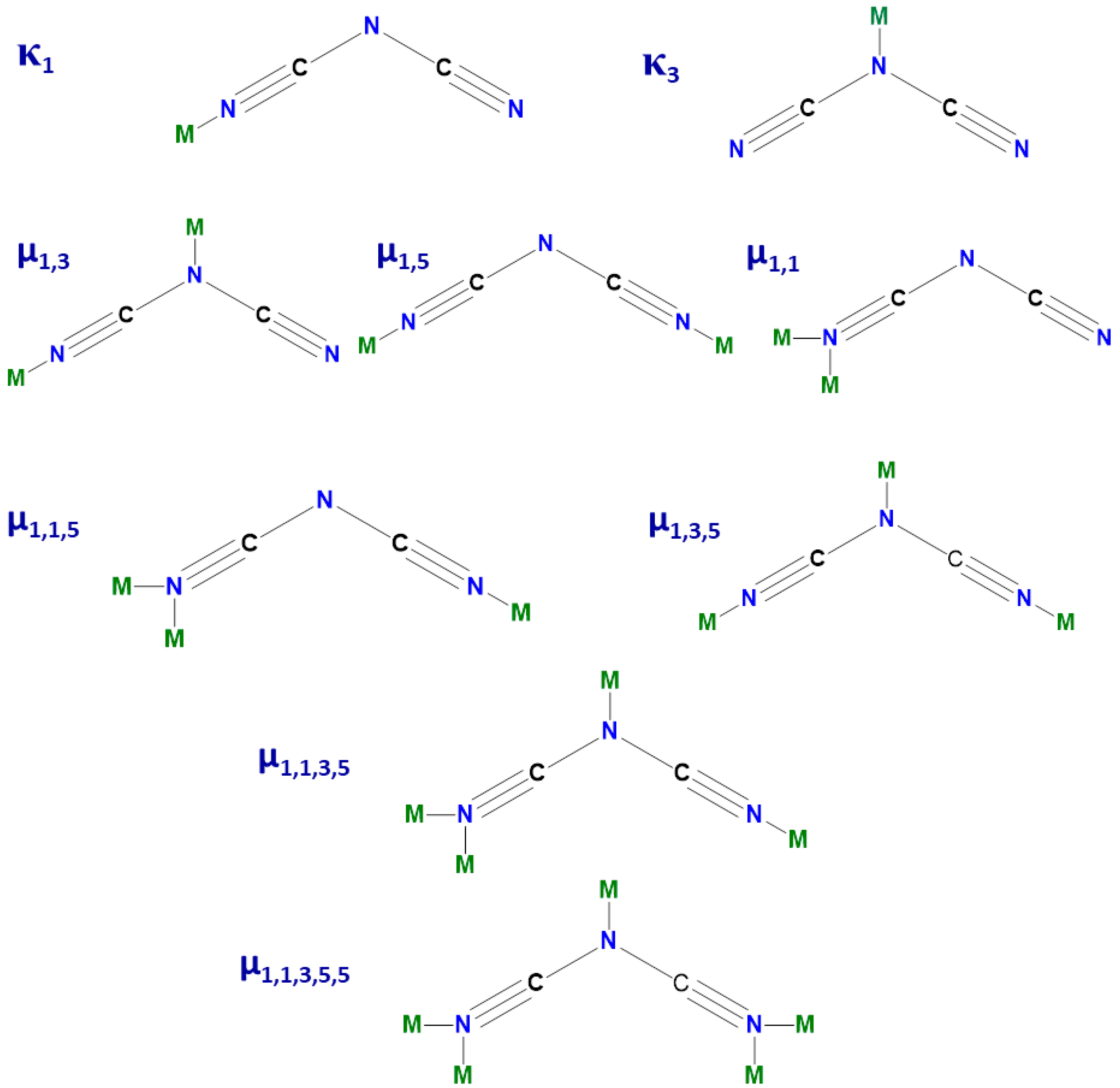
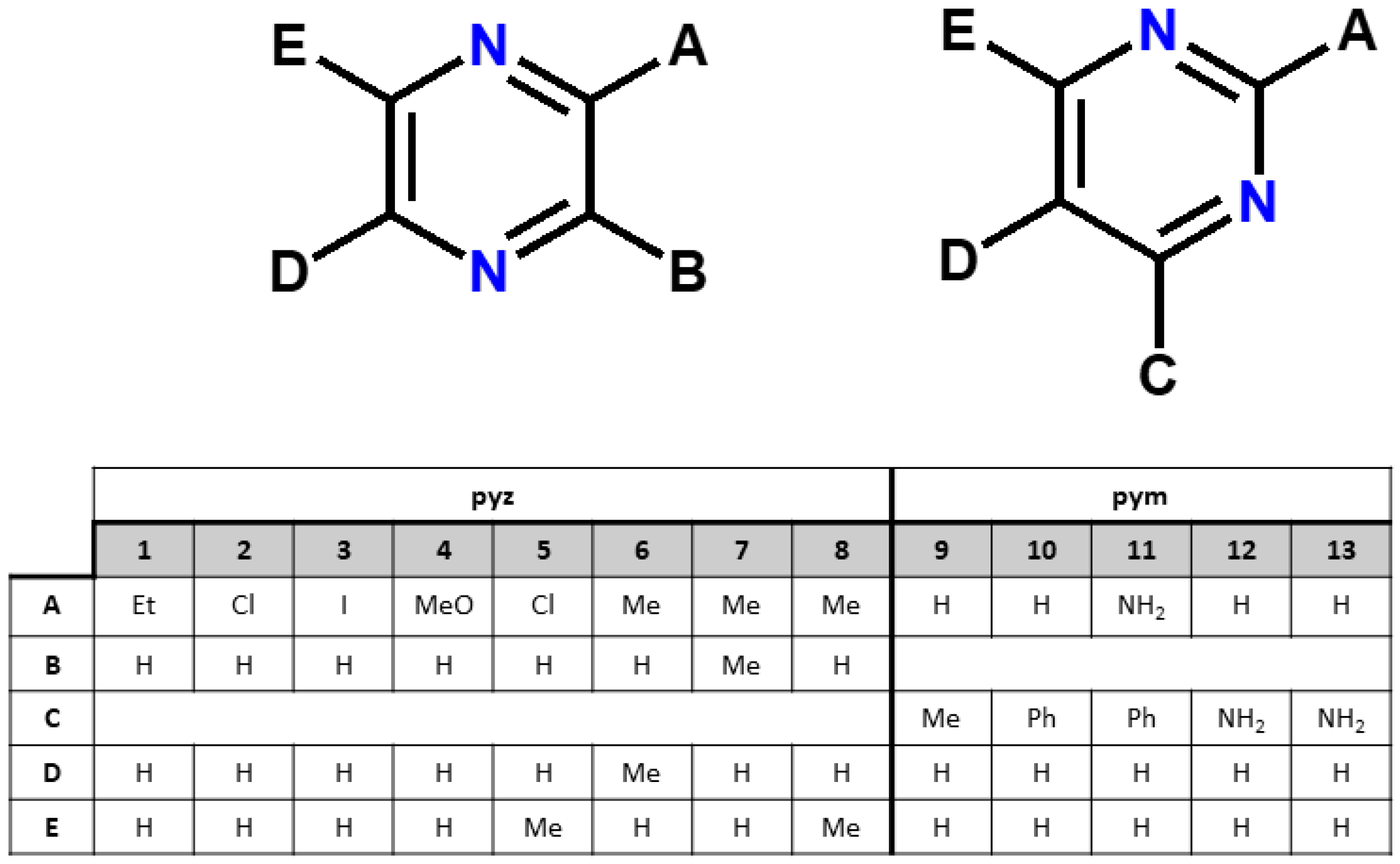
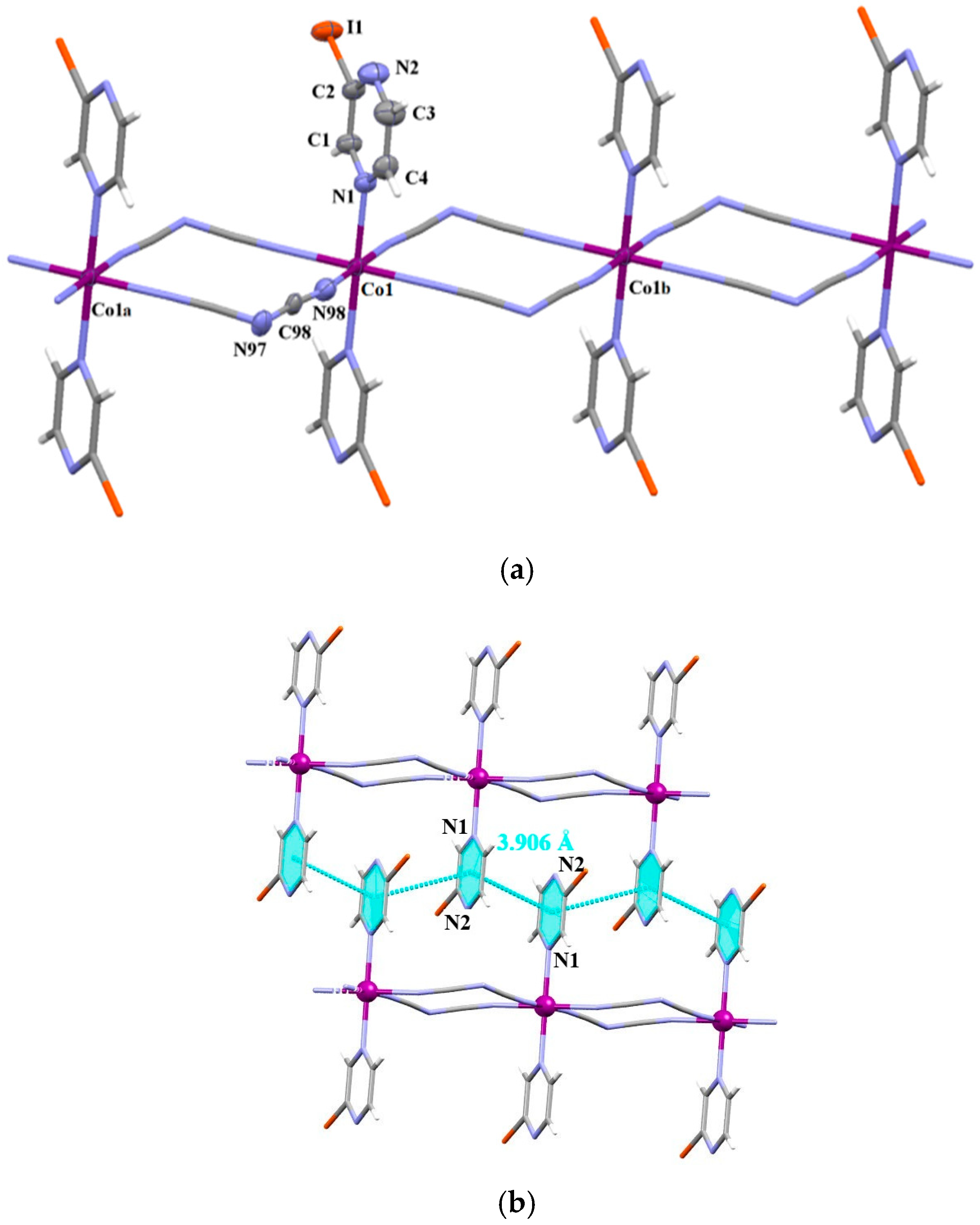
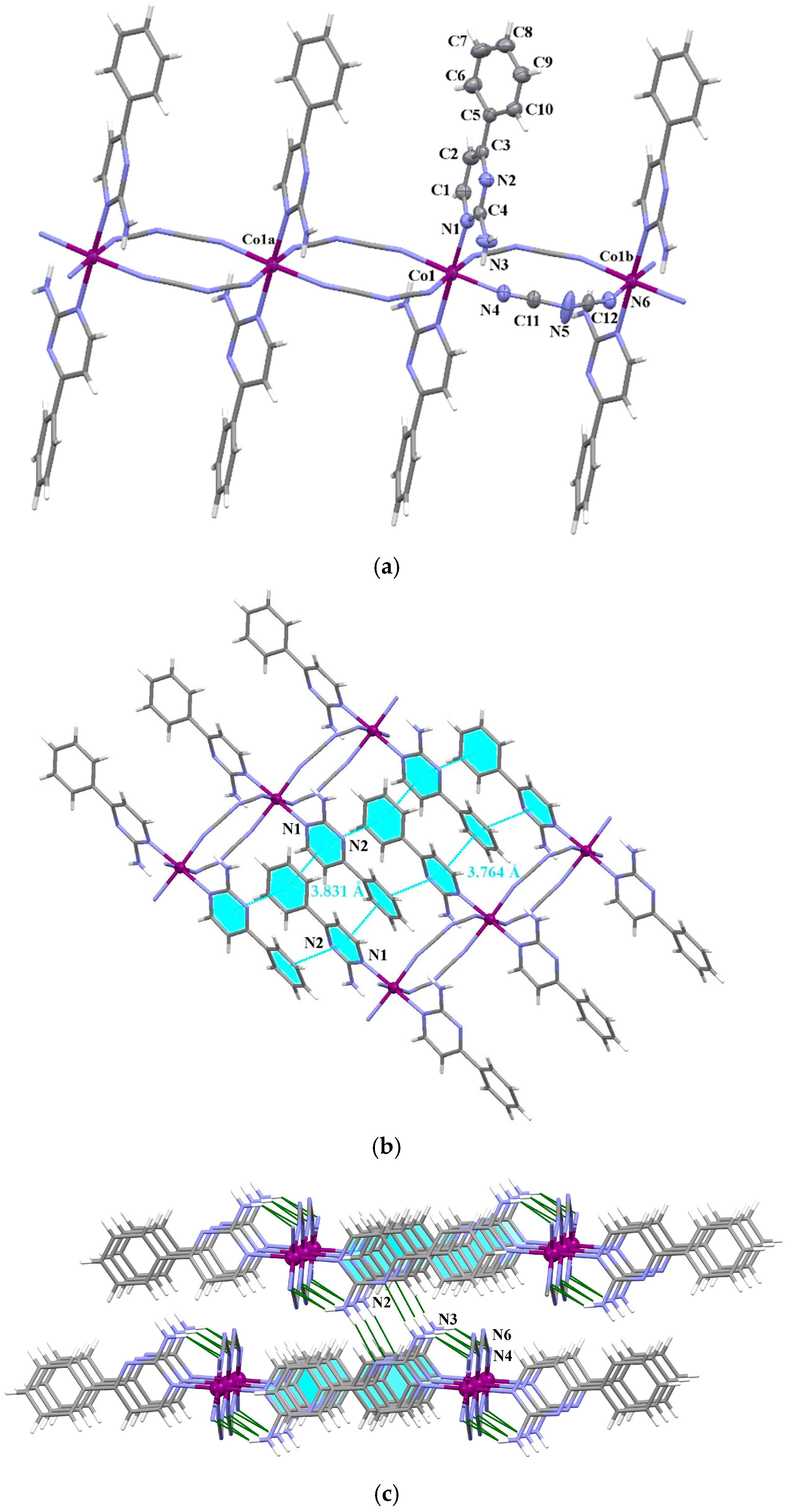
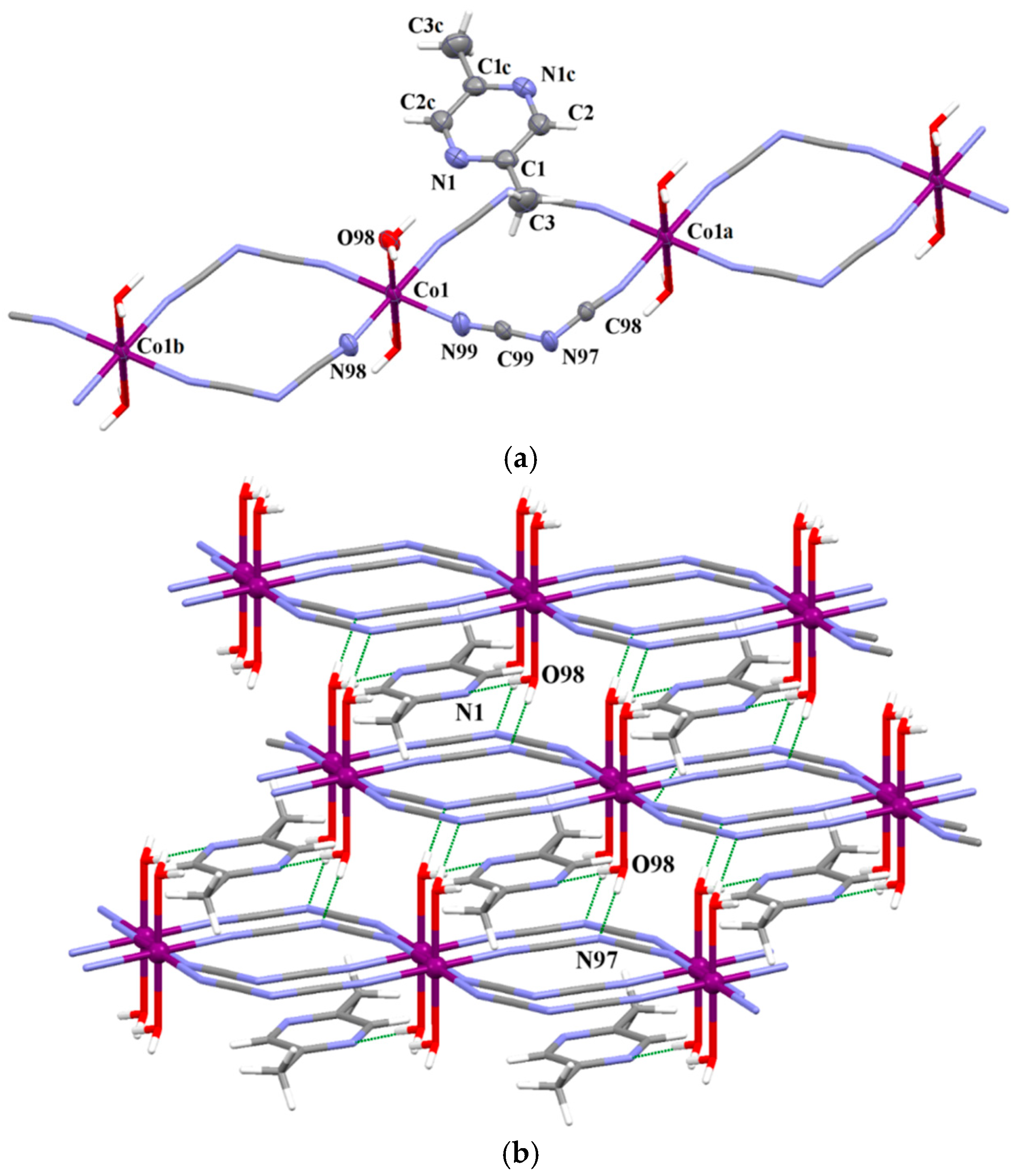

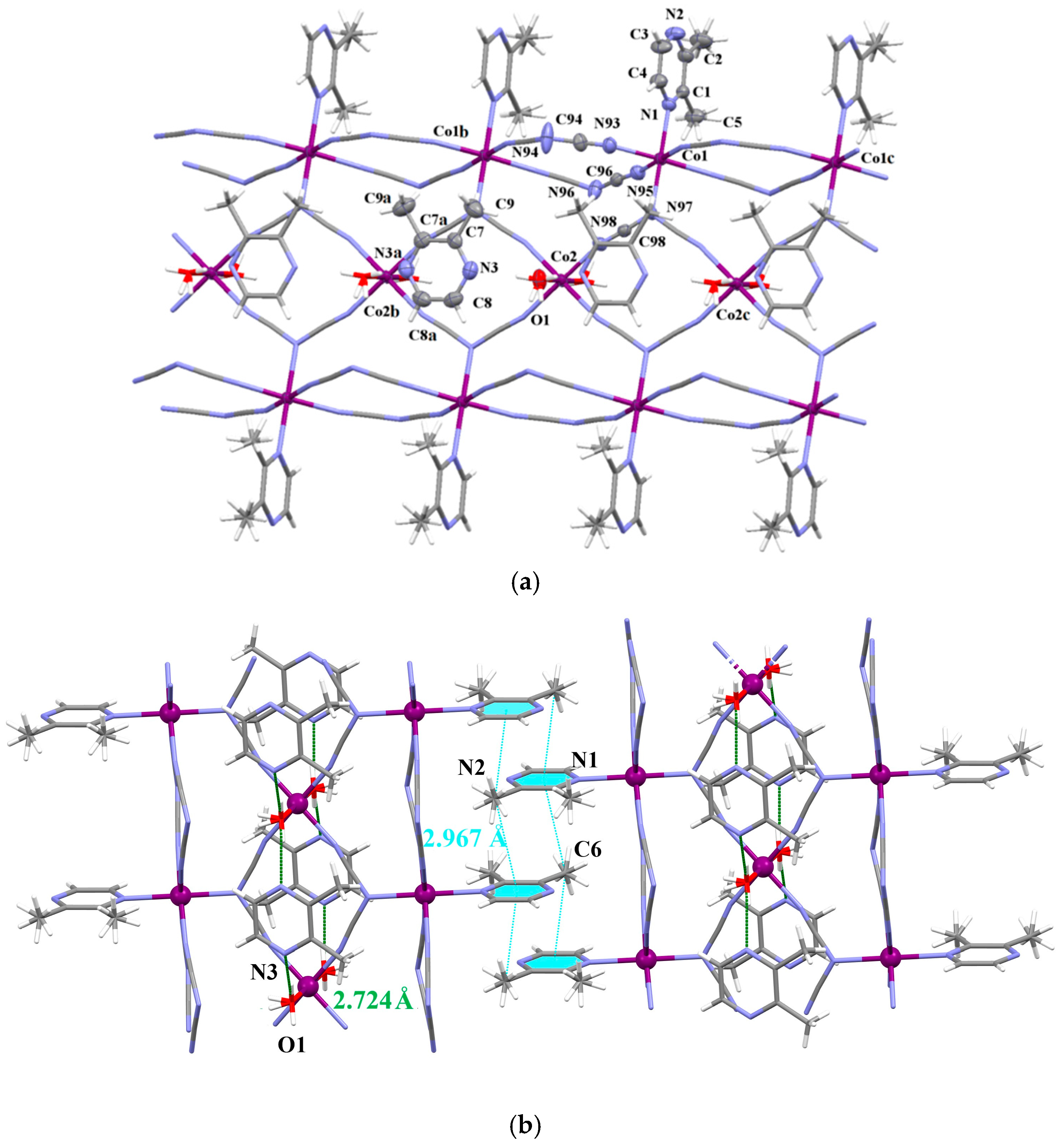
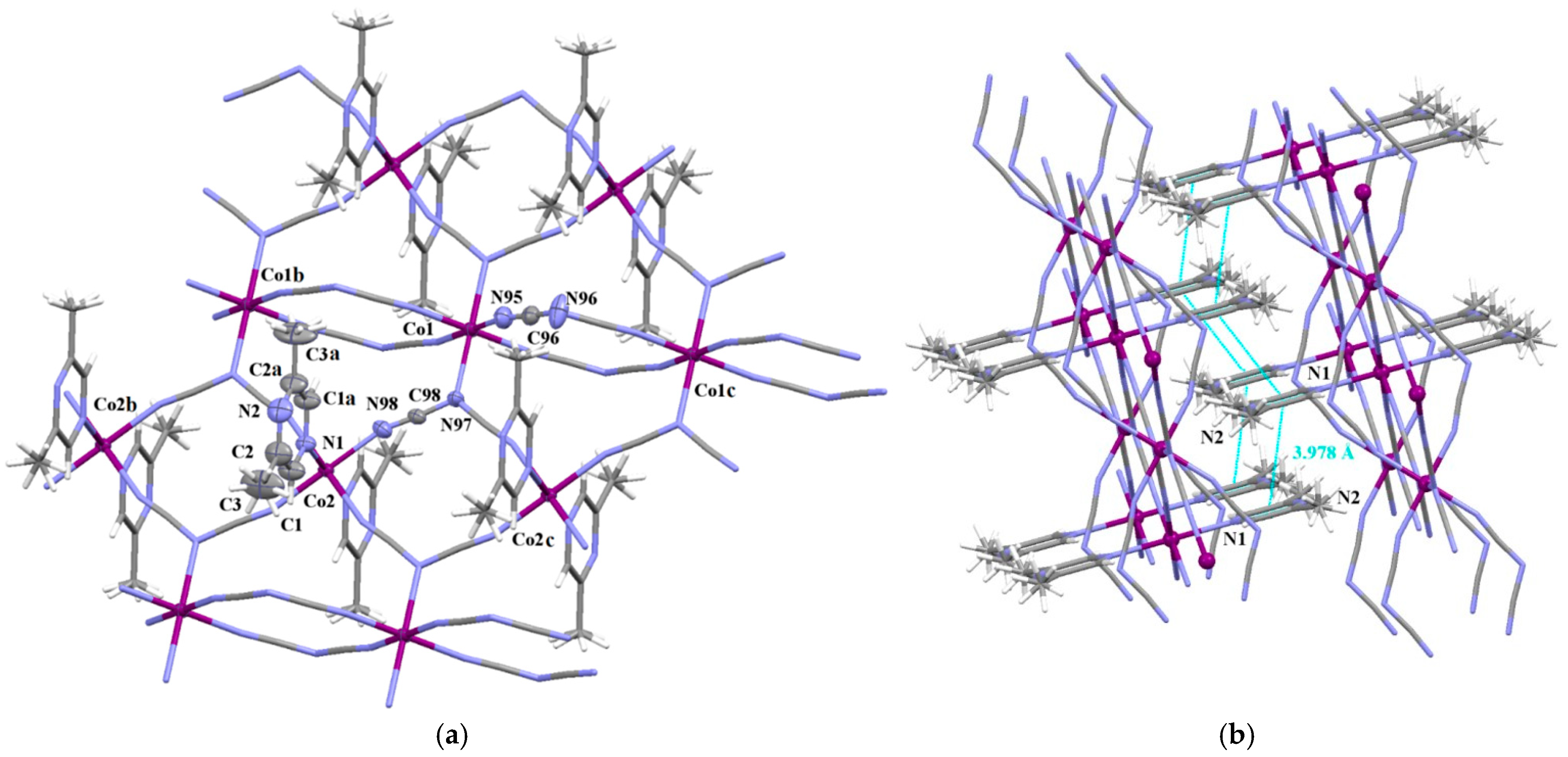

| Compound | λmax/nm(cm−1) | Dq/cm−1 | B/cm−1 | Β |
|---|---|---|---|---|
| 1 | 1077 (9285), 516 (19,379), 490 (20,408), 284 (35,211), 222 (45,045) | 1009 | 795 | 0.71 |
| 2 | 1037 (9643), 533 (18,761), 480 (20,833), 300 (33,333), 230 (43,478) | 911 | 711 | 0.63 |
| 3 | 1090 (9174), 506 (19,763), 482 (20,747), 296 (33,783), 226 (44,248) | 1059 | 866 | 0.78 |
| 4 | 1117 (8952), 535 (18,691), 497 (20,120), 294 (34,014), 228 (43,859) | 974 | 797 | 0.71 |
| 5 | 1086 (9208), 519 (19,268), 486 (20,576), 290 (34,483), 219 (45,662) | 1006 | 814 | 0.73 |
| 6 | 1166 (8576), 512 (19,531), 484 (20,661), 273 (36,630), 227 (44,053) | 1095 | 964 | 0.86 |
| 7 | 1146 (8726), 525 (19,047), 486 (20,576), 277 (36,101), 220 (45,455) | 1032 | 896 | 0.80 |
| 8 | 1108 (9025), 521 (19,194), 482 (20,747), 279 (35,842), 224 (43,668) | 1016 | 858 | 0.77 |
| 9 | 1075 (9302), 531 (18,832), 494 (20,243), 297 (33,670), 227 (44,052) | 745 | 953 | 0.85 |
| 10 | 1038 (9633), 532 (18,796), 502 (19,920) 341 (39,325), 325 (30,769), 265 (33,735), 221 (45,248) | 655 | 916 | 0.82 |
| 11 | 1132 (8833), 535 (18,691), 504 (19,841), 392 (25,510), 341 (29,325), 225 (44,444) | 802 | 986 | 0.88 |
| 12 | 1131 (8842), 517 (19,342), 495 (20,618), 281 (35,587), 224 (44,642) | 868 | 1050 | 0.94 |
| 13 | 1108 (9025), 534 (18,726), 501 (19,960), 333 (30,030), 290 (34,482), 223 (44,843) | 774 | 970 | 0.87 |
| Compound | 1 | 2 | 3 | 5 | 6 | 9 | 10 | 11 | 12 |
|---|---|---|---|---|---|---|---|---|---|
| Co–Ndca [Å] | 2.116(3) 2.120(3) | 2.1007(16) | 2.103(4) | 2.102(4) | 2.105(2) 2.113(3) | 2.1188(12) | 2.111(3) 2.101(3) 2.119(3) 2.126(3) | 2.1147(17) 2.1126(16) | 2.1260(16) |
| Co–Npyz/pym [Å] | 2.163(3) | 2.172(2) | 2.178(5) | 2.186(5) | 2.1541(16) | 2.177(3) 2.152(3) | 2.2032(15) | 2.128(2) | |
| Co–OH2 | 2.1220(19) | ||||||||
| ∠(C–N–C)dca [°] | 118.9(3) | 119.2(2) | 118.6(5) | 118.9(6) | 117.6(2) | 119.93(17) | 121.0(3) 120.5(3) | 124.0(2) | 118.0(2) |
| ∠(Co–N–C)dca | 162.0(3) 159.1(3) | 157.07(15) | 157.6(4) | 160.8(4) | 160.8(2) 163.6(2) | 157.59(12) | 152.5(3) 159.5(3) 162.5(3) 152.0(3) | 157.36(16) 156.96(17) | 156.57(16) |
| ∠(N–C–N)dca | 173.7(4) 174.6(3) | 174.66(19) | 174.5(4) | 175.3(5) | 175.6(3) 175.3(3) | 174.21(15) | 172.8(4) 173.1(4) 174.0(3) 174.1(3) | 173.5(2) 173.6(2) | 174.7(2) |
| Co•••Co * | 7.3512 | 7.3102 | 7.3235 | 7.2579 | 7.3240 | 7.386 | 7.367 | 7.438 | 7.330 |
| Compound | 4 | 7 | 8 |
|---|---|---|---|
| Co(1)–Ndca [Å] | 2.093(2) 2.104(2) 2.274(2) | 2.134(3) 2.092(3) 2.237(3) | 2.078(4) 2.210(4) |
| Co(2)–Ndca [Å] | 2.121(2) | 2.158(3) | 2.119(3) |
| Co(1)–Npyz [Å] | 2.152(3) | 2.232(3) | |
| Co(2)–Npyz [Å] | 2.175(4) | ||
| Co–OH2 [Å] | 2.029(3) | ||
| ∠(C–N–C)1,5–dca [°] | 118.7(3) | 121.7(4) 122.3(4) | 119.9(6) |
| ∠(Co–N–C)1,5–dca [°] | 151.9(2) 159.8(2) | 158.4(3) 159.2(3) | 160.6(4) |
| ∠(N–C–N)1,5–dca [°] | 174.7(2) 174.8(3) | 173.4(4) 174.2(3) | 173.9(5) |
| ∠(C–N–C)1,3,5–dca [°] | 117.0(2) | 116.6(3) | 117.6(5) |
| ∠(Co–N–C)1,3,5–dca [°] | 121.03(12) 163.07(16) | 120.62(17) 165.2(2) | 121.2(2) 162.7(3) |
| ∠(N–C–N)1,3,5–dca [°] | 175.7(2) | 175.8(3) | 175.4(4) |
| Co(1)•••Co(2) [Å] | 6.1415 | 6.1363 | 6.1042 |
| Co(1)•••Co(1d) [Å] | 7.3175 | ||
| Co(2)•••Co(2c) [Å] | 7.3175 | ||
| Co(1)•••Co(1b) [Å] | 7.4913 | 7.3500 | |
| Co(2)•••Co(2b) [Å] | 7.4913 | 7.3500 |
| 1 | 2 | 3 | 4 | 5 | 6 | 7 | 8 | 9 | 10 | 11 | 12 | 13 | |
|---|---|---|---|---|---|---|---|---|---|---|---|---|---|
| Space group | P | I2/m | C2/m | Pbam | C2/m | P | C2/m | Cmmm | I2/m | P | C2/m | C2/m | Pnma |
| Bridging ligands | μ1,5–dca | μ1,5–dca | μ1,5–dca | μ1,5–dca μ1,3,5–dca | μ1,5–dca | μ1,5–dca | μ1,5–dca μ1,3,5–dca | μ1,5–dca μ1,3,5–dca | μ1,5–dca | μ1,5–dca | μ1,5–dca | μ1,5–dca | μ1,5–dca 4-NH2-pym |
| Dimensionality | 1D | 1D | 1D | 1D | 1D | 1D | 1D | 2D | 1D | 1D | 1D | 1D | 3D |
Disclaimer/Publisher’s Note: The statements, opinions and data contained in all publications are solely those of the individual author(s) and contributor(s) and not of MDPI and/or the editor(s). MDPI and/or the editor(s) disclaim responsibility for any injury to people or property resulting from any ideas, methods, instructions or products referred to in the content. |
© 2025 by the authors. Licensee MDPI, Basel, Switzerland. This article is an open access article distributed under the terms and conditions of the Creative Commons Attribution (CC BY) license (https://creativecommons.org/licenses/by/4.0/).
Share and Cite
Palion-Gazda, J.; Świtlicka, A.; Choroba, K.; Malicka, E.; Machura, B.; Trzęsowska-Kruszyńska, A. Structural Diversity of Heteroleptic Cobalt(II) Dicyanamide Coordination Polymers with Substituted Pyrazines and Pyrimidines as Auxiliary Ligands. Molecules 2025, 30, 3856. https://doi.org/10.3390/molecules30193856
Palion-Gazda J, Świtlicka A, Choroba K, Malicka E, Machura B, Trzęsowska-Kruszyńska A. Structural Diversity of Heteroleptic Cobalt(II) Dicyanamide Coordination Polymers with Substituted Pyrazines and Pyrimidines as Auxiliary Ligands. Molecules. 2025; 30(19):3856. https://doi.org/10.3390/molecules30193856
Chicago/Turabian StylePalion-Gazda, Joanna, Anna Świtlicka, Katarzyna Choroba, Ewa Malicka, Barbara Machura, and Agata Trzęsowska-Kruszyńska. 2025. "Structural Diversity of Heteroleptic Cobalt(II) Dicyanamide Coordination Polymers with Substituted Pyrazines and Pyrimidines as Auxiliary Ligands" Molecules 30, no. 19: 3856. https://doi.org/10.3390/molecules30193856
APA StylePalion-Gazda, J., Świtlicka, A., Choroba, K., Malicka, E., Machura, B., & Trzęsowska-Kruszyńska, A. (2025). Structural Diversity of Heteroleptic Cobalt(II) Dicyanamide Coordination Polymers with Substituted Pyrazines and Pyrimidines as Auxiliary Ligands. Molecules, 30(19), 3856. https://doi.org/10.3390/molecules30193856








